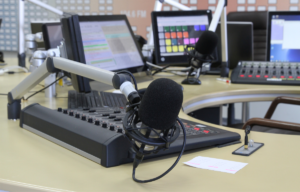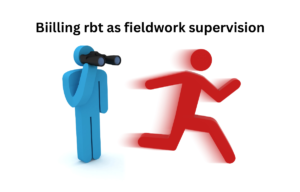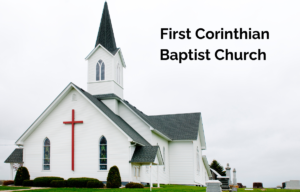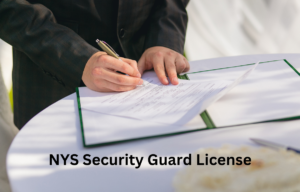Real estate photography is the art and practice of taking professional photographs of properties to showcase their features and appeal. It involves a combination of techniques, equipment, and skills tailored specifically to capture the best aspects of a property, whether it is a residential home, commercial building, or land. The primary goal is to create images that make the property appealing and inviting to potential buyers or renters, helping them visualize themselves in the space.
A majority of property searches begin online, the importance of high-quality real estate photography cannot be overstated. According to the National Association of Realtors, 87% of homebuyers rely on photos to make decisions, often before scheduling a viewing. Therefore, effective real estate photography can significantly impact a properties marketability, potentially leading to quicker sales or rentals at higher prices. This visual medium acts as the first point of contact between the property and prospective buyers, making it a critical component of any real estate marketing strategy.
The Impact of Real Estate Photography on Property Sales
High-quality real estate photos not only attract more viewers but also establish a sense of professionalism and trust. Properties with professional photos are perceived as more valuable, increasing the likelihood of attracting serious buyers and achieving competitive pricing. Listings with professional photos sell faster and for more money, as they stand out from the crowd and capture the attention of buyers scrolling through numerous listings online.
Professional photography provides a true representation of the property, minimizing discrepancies between the online listing and the actual property. This accuracy reduces the risk of buyer disappointment and helps maintain a positive reputation for real estate agents or sellers. In a market driven by visual impressions, investing in professional real estate photography is not just an option but a necessity to ensure a successful and profitable real estate transaction.
How to Choose the Key Feature of the Right Camera for Real Estate Photography?
Selecting the right camera for real estate photography involves assessing several key features that directly impact image quality. First and foremost, the camera should have a full-frame sensor, as it provides better image quality, especially in low-light conditions, and offers a wider dynamic range, which is essential for capturing details in both highlights and shadows. A high-resolution sensor is also important to produce sharp, detailed images that can be easily cropped or used in large formats.
Another important feature is the camera’s ability to shoot in RAW format. This allows for greater flexibility in post-processing, enabling photographers to adjust exposure, white balance, and other settings without compromising image quality. A camera with good low-light performance and noise reduction capabilities is crucial, as real estate photographers often shoot indoors or in conditions with limited natural light. Lastly, a robust autofocus system that performs well in various lighting conditions is essential for capturing sharp, well-focused images of both interiors and exteriors.
Recommended Cameras for Real Estate Photography
Several cameras stand out as top choices for real estate photography based on their features and performance. The Canon EOS 5D Mark IV is a popular option among professionals, offering a 30.4-megapixel full-frame sensor, excellent low-light performance, and a versatile autofocus system. Another strong contender is the Nikon D850, which features a 45.7-megapixel sensor and outstanding dynamic range, making it ideal for capturing high-resolution images with exceptional detail.
For those looking for a mirrorless option, the Sony Alpha a7 III provides a great balance of performance and price. It offers a 24.2-megapixel sensor, superb autofocus capabilities, and impressive low-light performance, making it a versatile choice for real estate photographers. For photographers who prefer a more compact and budget-friendly option, the Fujifilm X-T4 offers a 26.1-megapixel APS-C sensor, in-body image stabilization, and a wide range of high-quality lenses. Ultimately, the best camera for real estate photography depends on the photographer’s specific needs, budget, and shooting style.
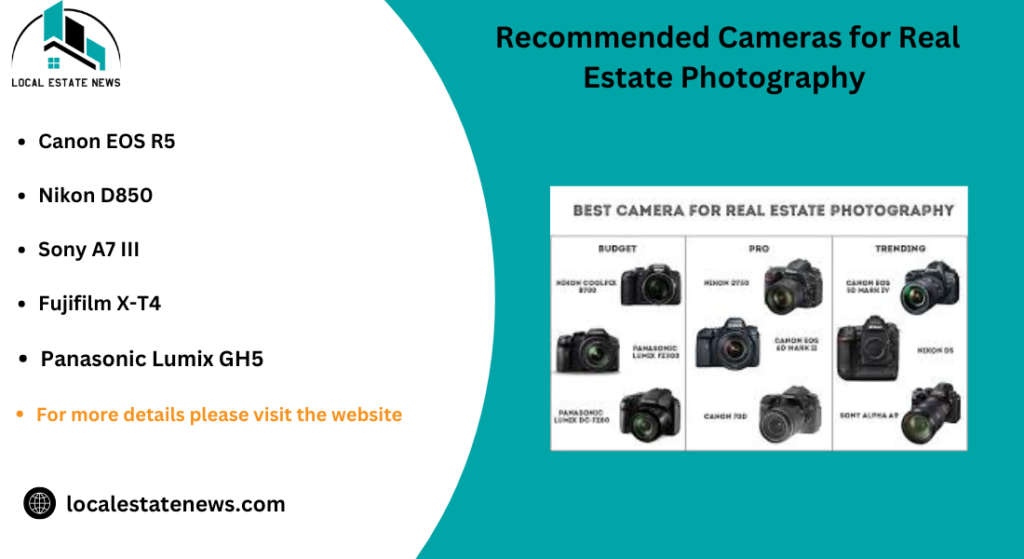
What are the Best Settings for a Real Estate Photography Camera?
Achieving the best results in real estate photography requires careful attention to camera settings. Start by setting the camera to aperture priority mode (A or Av), which allows you to control the depth of field while the camera automatically adjusts the shutter speed. A smaller aperture (higher f-stop, e.g., f/8 to f/11) is recommended to ensure that both the foreground and background are in sharp focus, which is particularly important for interior shots where details in all parts of the room need to be visible.
ISO settings should be kept as low as possible (e.g., ISO 100 or 200) to minimize noise, especially in darker indoor environments. If natural light is insufficient, consider using a tripod to stabilize the camera, allowing for longer exposure times without camera shake. This setup helps in maintaining a lower ISO while achieving well-exposed images.
White balance is another critical setting, as it affects the color accuracy of your images. It is recommended to use the auto white balance setting if you’re shooting in varying light conditions, or manually adjust the white balance based on the lighting environment (e.g., daylight, tungsten, or fluorescent) to ensure that the colors in the images are true to life.
Tips for Shooting with HDR and Bracketing
High Dynamic Range (HDR) photography is a technique commonly used in real estate photography to capture a greater range of light and shadow details in a scene. To effectively utilize HDR, set your camera to bracketing mode, which allows the camera to take multiple shots at different exposure levels, a series of three to five bracketed shots, ranging from underexposed to overexposed, are captured and later combined in post-processing software to create a single image with enhanced dynamic range.
When shooting HDR, use a tripod to keep the camera steady during the multiple exposures and ensure that the composition remains consistent across all shots. Keep the camera’s focus and white balance settings constant throughout the bracketed sequence to maintain uniformity in the final HDR image. This technique is especially useful for challenging lighting conditions, a room with bright windows and darker interior spaces, allowing you to showcase the property with balanced lighting and vivid details.
How Can Lighting Improve Real Estate Photography?
Lighting is a critical element in real estate photography, as it significantly influences the mood, clarity, and appeal of the images. Proper lighting can highlight the best features of a property, create depth, and enhance colors, making the photos more inviting and realistic. Natural light is often preferred in real estate photography because it provides a true representation of how the property looks in its natural setting. Photographers typically schedule shoots during the golden hours (early morning or late afternoon) when the light is soft and diffused, reducing harsh shadows and glare.
For interior shots, strategically placing lights can brighten up darker areas and create a balanced exposure across the room. Utilizing techniques, bounced flash, where the flash is directed towards the ceiling or walls, can help in diffusing light and reducing harsh shadows, using light modifiers like softboxes and reflectors can control the quality and direction of light, ensuring that the space is well-lit and visually appealing. Proper lighting not only improves the aesthetics of the photos but also ensures that the property is presented accurately and attractively to potential buyers.
Techniques and Tools for Effective Lighting
Several techniques and tools are available to achieve optimal lighting in real estate photography. One common approach is using multiple light sources to fill in shadows and create a more uniform exposure. For example, combining ambient light with artificial lights, lamps or strobes, can add depth and dimension to the photos. Photographers often use LED light panels or portable flash units to supplement natural light, especially in areas where natural light is insufficient or uneven.
Effective technique is light painting, where the photographer uses a handheld light source to illuminate specific areas of the room while the camera shutter remains open for an extended period. This method allows for greater control over the lighting and can be particularly useful for highlighting architectural details or creating a specific mood. For exterior shots, using polarizing filters can help in reducing reflections and enhancing the color of the sky and foliage, making the property stand out more vividly. By employing these techniques and tools, real estate photographers can create images that are not only visually appealing but also accurately represent the property’s features and ambiance.
What are the Must-Have Lenses for Real Estate Photography?
Lenses play a crucial role in real estate photography, as they determine the perspective, field of view, and depth of the images. The choice of lens can greatly affect how the property is perceived, making it essential for photographers to select the right lens for each shot. Wide-angle lenses are a staple in real estate photography because they allow photographers to capture more of the room in a single shot, making spaces appear larger and more spacious. These lenses are particularly useful for small rooms or tight spaces, where a standard lens may not be able to capture the entire scene.
It is important to use wide-angle lenses judiciously, as excessive use can lead to distortion, making objects appear stretched or skewed. To mitigate this, photographers should aim to shoot at moderate focal lengths and avoid extreme wide-angle settings. Using tilt-shift lenses can help in correcting perspective distortion, especially in architectural photography, where straight lines and angles are crucial. Tilt-shift lenses allow photographers to control the plane of focus, ensuring that vertical lines remain straight and the overall composition is balanced.
Recommended Lenses for Different Scenarios
Different scenarios in real estate photography may require different types of lenses to achieve the desired effect. For general interior shots, a 24-70mm f/2.8 lens is a versatile option, offering a good balance between wide-angle and telephoto capabilities. This lens is suitable for capturing a wide range of scenes, from small rooms to large open spaces, and provides excellent image quality and flexibility.
For photographers who specialize in capturing large properties or exteriors, a 70-200mm f/2.8 telephoto lens can be a valuable addition to the kit. This lens allows for shooting from a distance while maintaining a close-up view of the property, which is useful for highlighting architectural details or capturing panoramic views. The recommended lens is the 14-24mm f/2.8 ultra-wide-angle lens, ideal for capturing expansive interiors or dramatic exterior shots. This lens offers a unique perspective and can create a sense of depth and scale, making it a popular choice among real estate photographers.
How to Compose and Frame Shots in Real Estate Photography?
Composition is a fundamental aspect of real estate photography, as it determines how the elements within the frame are arranged and presented to the viewer. A well-composed photo can draw attention to the key features of the property, create a sense of balance, and guide the viewers eye through the image. The basic principles of composition is the rule of thirds, which involves dividing the frame into a 3×3 grid and placing the subject or points of interest along the grid lines or at their intersections. This technique creates a more dynamic and visually appealing image, as it avoids placing the subject directly in the center of the frame.
Important aspect of composition is the use of leading lines, which are lines within the image that guide the viewer’s eye towards the main subject or through the scene. In real estate photography, leading lines can be created by architectural elements hallways, staircases, or rooflines. Incorporating elements of symmetry and balance can enhance the visual appeal of the photos, making the space appear more harmonious and inviting. By carefully considering the composition and framing of each shot, real estate photographers can create images that not only showcase the property but also engage and captivate the viewer.
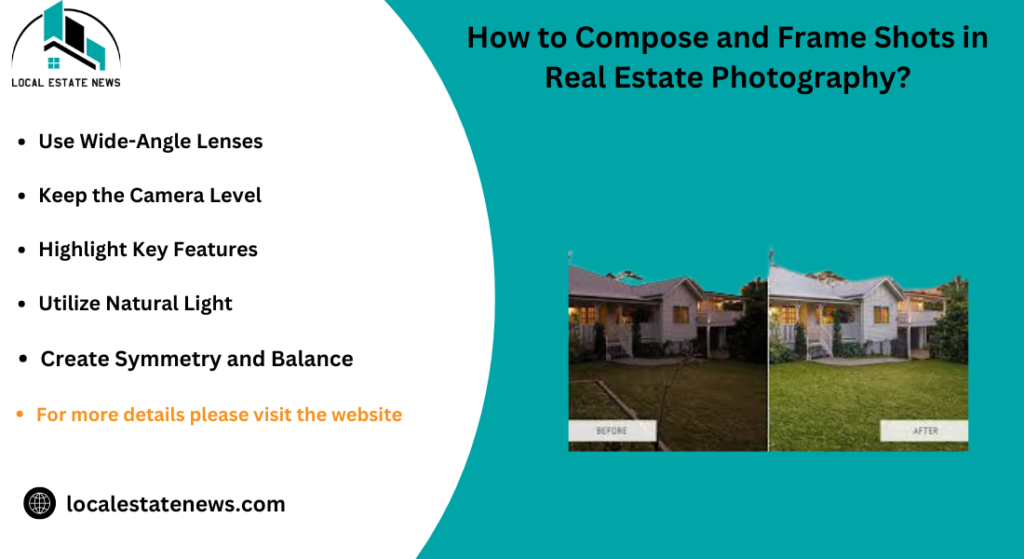
Techniques for Effective Framing
Framing is another essential technique in real estate photography that involves using elements within the scene to create a natural frame around the subject. This technique can add depth and context to the image, drawing attention to the property and its features. For example, doorways, windows, and archways can be used to frame the interior or exterior views, creating a sense of depth and perspective. Framing can also help in isolating the subject from distracting elements in the background, ensuring that the focus remains on the property.
By using architectural elements for framing, photographers can also employ creative angles and perspectives to enhance the visual impact of the photos. Shooting from a low angle can make a room appear larger and more spacious, while shooting from a high angle can provide a comprehensive view of the space. Experimenting with different angles and perspectives allows photographers to capture unique and compelling images that highlight the properties best features and create a lasting impression on potential buyers.
What are the Best Angles for Capturing Different Rooms/Spaces ?
Choosing the right angles is crucial in real estate photography to showcase a rooms dimensions, features, and overall appeal. For living rooms and common areas, shooting from the corner of the room can provide a wide perspective, capturing the spaces layout and any architectural features like fireplaces or built-in shelving. This angle helps to highlight the rooms size and openness, making it more inviting to potential buyers. Positioning the camera slightly higher than usual can also enhance the sense of depth and spaciousness, especially in rooms with low ceilings.
In bedrooms, the goal is to create a cozy and comfortable atmosphere. Shooting from the doorway or corner opposite the bed can help capture the rooms layout, emphasizing the bed as the focal point. Ensuring that the bed, windows, and any seating areas are all visible in the frame helps to give a complete view of the space. In smaller rooms, using a wide-angle lens and shooting from the farthest corner can help the room appear larger and more open, avoiding a cramped look.
Angles for Kitchens and Bathrooms
Kitchens and bathrooms often feature a lot of details and fixtures that need to be highlighted to attract buyers. For kitchens, shooting from a low angle can help capture the countertops, cabinets, and appliances in one shot, showcasing the kitchen’s functionality and design. Including features of the sink, stove, and island in the frame helps to give a comprehensive view of the kitchen. If the kitchen has unique features like a backsplash, range hood, or lighting, it is beneficial to take close-up shots from different angles to highlight these details.
In bathrooms, it is essential to capture the cleanliness and modern features of the space. Shooting from the doorway with a wide-angle lens can help encompass the entire bathroom, including the shower, bathtub, sink, and toilet. To avoid distortions and reflections, it is best to keep the camera at a level angle, parallel to the floor. Focusing on key features like the vanity, tile work, and fixtures can enhance the overall appeal of the bathroom and provide potential buyers with a clear sense of the space.
How to Use/Benefits of HDR in Real Estate Photography?
High Dynamic Range (HDR) photography is a technique used to capture a greater range of lighting in a scene, which is especially useful in real estate photography. HDR allows photographers to balance the exposure between the interior of a room and the exterior views through windows. This technique helps to avoid blown-out highlights or overly dark shadows, providing a more realistic and detailed representation of the property. Combining multiple exposures of the same scene, HDR photography can create images that showcase both the bright outdoor light and the interior details without compromising on either.
HDR in real estate photography can significantly enhance the visual appeal of the photos, making them more attractive to potential buyers. Well-executed HDR images can highlight the properties features, large windows, open floor plans, and architectural details, which might otherwise be lost in standard photos. This level of detail and clarity can help create a positive first impression, encouraging potential buyers to explore the property further.
Techniques for Capturing and Processing HDR Images
To effectively capture HDR images, photographers use a tripod to ensure stability and maintain consistent framing across multiple exposures. The camera is set to bracket mode, taking a series of shots at different exposure levels (usually three to five exposures ranging from underexposed to overexposed). This bracketing technique ensures that the photographer captures all the details in both the shadows and highlights.
The images are captured and combined using HDR processing software Adobe Lightroom, Photomatix, or Aurora HDR. These programs align the images and merge them into a single photo, allowing the photographer to adjust the exposure, and color balance to achieve the desired effect. It is essential to avoid over-processing the images, as this can lead to an unnatural or exaggerated look. The goal of HDR in real estate photography is to create realistic and appealing images that accurately represent the property’s lighting and features.
What Editing Software is Best for Real Estate Photography?
The right editing software can make a significant difference in the quality of real estate photos, enabling photographers to enhance the images and correct any imperfections. Adobe Photoshop and Adobe Lightroom are two of the most popular choices among real estate photographers. Adobe Lightroom offers a range of tools specifically designed for photo editing, exposure adjustment, color correction, and noise reduction. It also allows for batch processing, making it easier to apply the same edits to multiple photos, which is a time-saving feature for real estate photographers who need to edit large volumes of images.
Adobe Photoshop, on the other hand, provides more advanced editing capabilities, removing unwanted objects, correcting lens distortions, and blending multiple exposures for HDR photography. It also offers a wide range of filters and effects that can be used to enhance the overall look of the images. For real estate photographers who require detailed control over their images, Photoshops extensive tools and features make it an excellent choice.
Other Useful Editing Software and Tools
In addition to Adobe products, several other editing software options are well-suited for real estate photography. Capture One Pro is a professional-grade photo editing software that offers advanced color grading, tethered shooting capabilities, and high-quality RAW processing. Its intuitive interface and powerful tools make it a favorite among photographers who prioritize image quality and color accuracy.
Option is Luminar Neo, which features AI-powered editing tools that simplify the editing process and enhance the overall look of the photos. Luminar Neo offers features, sky replacement, sunrays, and portrait enhancements, which can be particularly useful for real estate photographers looking to create stunning and eye-catching images. ON1 Photo RAW is a comprehensive photo editing software that combines photo management, editing, and effects in one platform. It offers a wide range of tools and presets that can help photographers streamline their workflow and produce high-quality real estate photos.
How to Retouch and Enhance Real Estate Photos for Listing?
Retouching and enhancing real estate photos are crucial steps in ensuring that the images are visually appealing and accurately represent the property. These processes involve correcting any flaws, adjusting lighting, and enhancing colors to make the property look its best. The goal of retouching is not to misrepresent the property but to ensure that the images are free of distractions and showcase the properties features effectively. This can help in attracting potential buyers, as high-quality images create a strong first impression and can lead to more inquiries and showings.
Common retouching techniques include removing minor imperfections, scratches on walls, dust on furniture, and reflections in mirrors or windows. Adjusting the brightness and contrast can also help in highlighting the key features of a room, making the images more dynamic and engaging.. Correcting the color balance can ensure that the images accurately reflect the natural tones of the property, which is important for providing a realistic representation to potential buyers.
Techniques and Tools for Effective Photo Enhancement
Various tools and techniques are available for retouching and enhancing real estate photos. Adobe Lightroom and Photoshop are widely used by photographers for their robust features and capabilities. Lightroom offers batch processing, which allows photographers to apply the same adjustments to multiple images, saving time and ensuring consistency across all photos. This includes basic adjustments, exposure, contrast, and color balance, as well as more advanced features like selective adjustments and gradient filters.
Photoshop, on the other hand, provides more advanced retouching capabilities, removing unwanted objects or adjusting the perspective of images. Photographers can also use Photoshop to merge multiple exposures for HDR photography, creating images with a higher dynamic range and more detail. For those looking for a more automated solution, software like Skylum’s Luminar and ON1 Photo RAW offer AI-powered editing tools that can quickly enhance images with minimal effort. These tools include features like sky replacement, noise reduction, and automatic adjustments for exposure and color balance, making them ideal for real estate photographers looking to streamline their workflow and produce high-quality images.
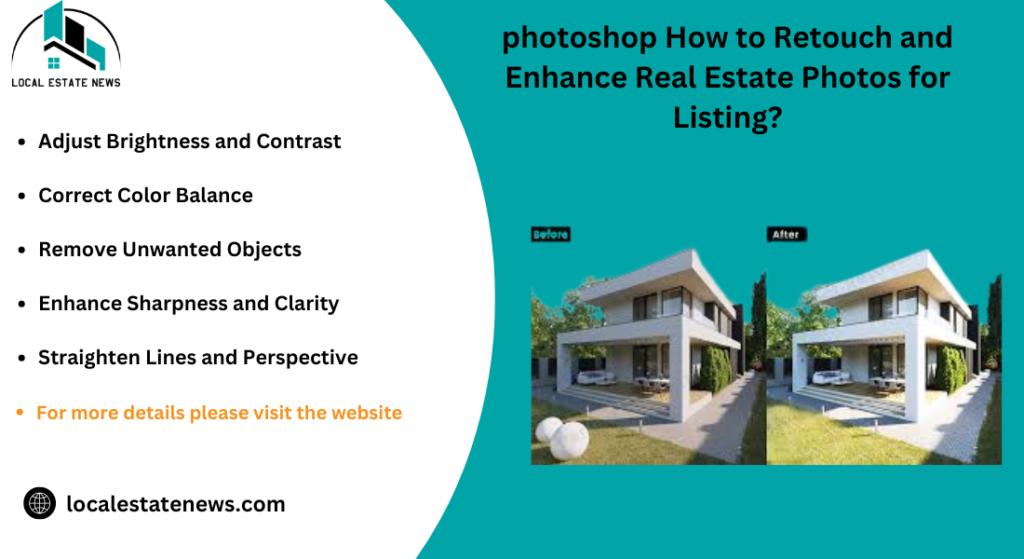
What are the Common Mistakes in Real Estate Photography and How to Avoid Them?
Real estate photography can be challenging, and even experienced photographers can make mistakes that negatively impact the quality of their images. One of the most common mistakes is poor composition, which can result in images that are cluttered or unbalanced. This can be avoided by following basic composition guidelines, the rule of thirds, and by paying attention to the placement of objects within the frame. Failing to prepare the property before the shoot can lead to distracting elements in the images, clutter, personal items, or messy spaces. It’s important to ensure that the property is clean and staged appropriately before the photography session begins.
Common mistake is using inappropriate lighting techniques, which can result in images that are too dark, too bright, or have harsh shadows. To avoid this, photographers should be familiar with the different types of lighting and how they can be used to create the desired effect. This includes using natural light, artificial light, or a combination of both, and adjusting the camera settings accordingly. Photographers should be mindful of the time of day and weather conditions, as these can significantly impact the quality of the light and the overall look of the images.
Tips for Avoiding Mistakes and Improving Your Photography
To avoid these common mistakes and improve the quality of your real estate photography, it is important to plan and prepare for each shoot. This includes scouting the location beforehand, checking the weather forecast, and making a list of the key features and angles that you want to capture. Practicing with different camera settings and lighting techniques can help you become more familiar with your equipment and improve your ability to adapt to different shooting conditions.
An important tip is to invest in quality equipment and accessories, a tripod, wide-angle lens, and lighting modifiers. These tools can help you capture sharper, more detailed images and achieve better lighting and composition. Take the time to review and edit your images after each shoot, using software like Adobe Lightroom or Photoshop to correct any imperfections and enhance the overall look of the photos. By following these tips and avoiding common mistakes, you can create high quality images that effectively showcase the property and attract potential buyers.
How to Shoot Real Estate Photos in Low Light Conditions?
Shooting real estate photos in low-light conditions can be challenging, as it requires a careful balance between capturing enough light to illuminate the space and avoiding noise or blurriness in the images. Common issues encountered in low-light photography include underexposed images, loss of detail in shadows, and graininess due to high ISO settings. These challenges can be particularly prevalent in interior spaces with limited natural light, basements, windowless rooms, or properties photographed during the evening.
To overcome these challenges, it is important to use appropriate camera settings and equipment. And the most effective way to deal with low light is to use a tripod, which allows you to stabilize the camera and use slower shutter speeds without introducing camera shake. This can help you capture more light and produce clearer, more detailed images.. Using a wide aperture (low f-stop number) can allow more light into the camera, making it easier to achieve a well-exposed image. And you can get Complete Guide to Selling a House in real estate
Techniques for Effective Low-Light Photography
Several techniques can be employed to improve the quality of real estate photos taken in low-light conditions. One approach is to use multiple light sources, lamps, flash units, or LED panels, to brighten the space and reduce shadows. This can help create a more even exposure and highlight the key features of the room.. Using a remote trigger or a timer can prevent camera shake when pressing the shutter button, further improving the sharpness of the images.
Technique is to shoot in RAW format, which provides greater flexibility in post-processing and allows you to adjust exposure, white balance, and noise reduction more effectively. In post-processing software like Adobe Lightroom, you can increase the exposure and reduce noise to enhance the overall quality of the images. Using HDR photography can be beneficial in low-light situations, as it allows you to capture multiple exposures and combine them to create a single image with a wider dynamic range. By employing these techniques and making use of the right equipment, you can capture high-quality real estate photos even in challenging low-light conditions.
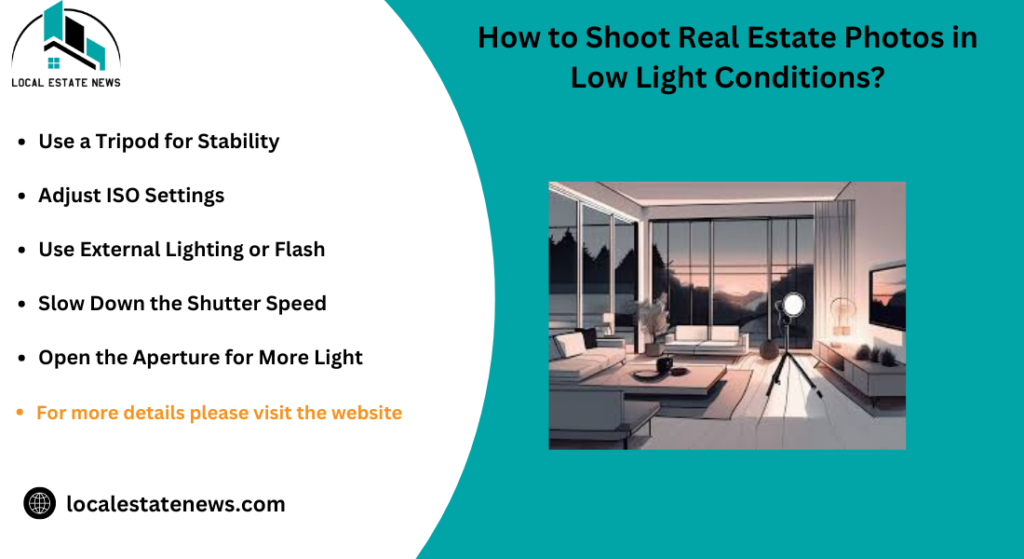
What are the Benefits of Using Drones in Real Estate Photography?
Drones have revolutionized real estate photography by providing unique and compelling perspectives that were previously difficult to achieve. The primary benefits of using drones is the ability to capture aerial shots of properties, showcasing the properties layout, surrounding environment, and proximity to amenities like parks, bodies of water, and other landmarks. These high-angle views give potential buyers a comprehensive understanding of the property and its context within the neighborhood, which is particularly beneficial for large estates, waterfront properties, or homes located near significant attractions.
Providing a birds-eye view of the property, drones can capture unique angles and features that are not possible with traditional ground photography. For example, they can highlight architectural details, roof conditions, and landscaping, giving a more complete picture of the properties attributes. This enhanced perspective can be especially appealing to buyers who are interested in properties with expansive grounds or special features, as it allows them to appreciate the property’s full potential before visiting in person.
Marketing and Competitive Advantages of Drone Photography
Using drones in real estate photography can also offer significant marketing and competitive advantages. Properties that are showcased with high-quality drone footage and images tend to stand out in listings, attracting more attention and generating higher engagement from potential buyers. According to the National Association of Realtors, listings with aerial images are 68% more likely to sell faster than those without. This increased visibility and appeal can lead to quicker sales and higher selling prices, benefiting both sellers and real estate agents.
Incorporating drone photography into a marketing strategy can help real estate professionals differentiate themselves from competitors who may not offer this service. By providing a more immersive and visually engaging experience, real estate agents can enhance their brand image and reputation, positioning themselves as innovative and forward-thinking in a competitive market. With the growing popularity and accessibility of drone technology, investing in drone photography can be a valuable asset for any real estate professional looking to enhance their marketing efforts and achieve better results.
How to Stage a Property for Optimal Real Estate Photography?
Staging a property is a crucial step in real estate photography that can significantly impact the appeal and effectiveness of the images. Proper staging involves arranging furniture, decor, and other elements in a way that highlights the property’s best features and creates an inviting atmosphere. Staging helps potential buyers visualize themselves living in the space, making it more likely for them to form an emotional connection with the property. According to the Real Estate Staging Association, staged homes sell 73% faster than non-staged homes, emphasizing the importance of staging in the selling process.
The key benefits of staging is that it allows photographers to capture images that are both aesthetically pleasing and functionally relevant. For example, arranging furniture to create clear pathways and focal points can help guide the viewer’s eye through the space, making the room appear larger and more cohesive. Using neutral colors and minimal decor can prevent distractions and ensure that the focus remains on the property’s features, architectural details, natural light, and spaciousness.
Tips and Strategies for Effective Staging
To stage a property effectively for real estate photography, it is important to start with a clean and decluttered space. This involves removing personal items, excess furniture, and any unnecessary decor that may distract from the properties features. Cleaning windows, floors, and surfaces can also enhance the overall appearance of the space, making it more appealing in photos. Once the space is clean, arranging furniture and decor in a way that highlights the properties best features is key. For example, positioning furniture to showcase a fireplace, large windows, or a beautiful view can create a focal point and draw attention to these features.
For furniture placement, lighting plays a crucial role in staging a property for photography. Ensuring that all lights are turned on and that curtains and blinds are open can maximize the natural light in the space, creating a warm and inviting atmosphere. Using decorative lighting, floor lamps or table lamps, can also add depth and dimension to the photos.. Adding small touches like fresh flowers, colorful throw pillows, or a well-placed piece of artwork can enhance the overall look and feel of the space, making it more attractive to potential buyers.
What are the Legal and Ethical Considerations in Real Estate Photography?
Real estate photography involves various legal and ethical considerations that photographers and real estate professionals must be aware of to avoid potential liabilities and disputes. One of the primary legal concerns is obtaining permission to photograph properties, especially when using drone technology. The Federal Aviation Administration (FAA) requires drone operators to obtain a remote pilot certificate and follow specific regulations, including flying below 400 feet, maintaining visual line-of-sight, and avoiding flying over people or moving vehicles. Failure to comply with these regulations can result in fines and legal action.
Legal issue in real estate photography is ensuring that all photographs accurately represent the property. Misrepresenting a property through deceptive editing or staging can lead to legal disputes and damage the reputation of the photographer and real estate agent. It is important to present the property in a truthful and transparent manner, highlighting its features without exaggeration or manipulation. This includes avoiding the use of filters or editing techniques that significantly alter the appearance of the property, as this can mislead potential buyers and result in legal consequences.
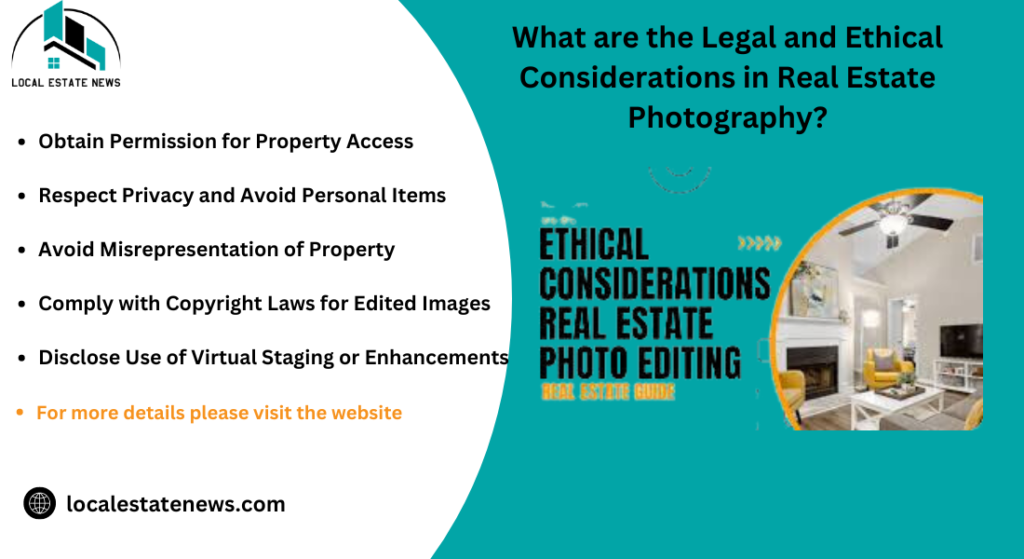
Ethical Considerations and Best Practices
To legal issues, real estate photography also involves ethical considerations that professionals should adhere to in order to maintain trust and credibility with clients and buyers. One important ethical consideration is respecting the privacy of the properties occupants. This includes ensuring that personal items, family photos, and other private details are not included in the photographs without permission. It is also important to respect the properties boundaries and avoid photographing neighboring properties or areas that are not part of the listing.
All parties involved in the transaction are treated fairly and with respect. This includes being transparent about the services provided, the costs involved, and any potential conflicts of interest. By adhering to these ethical standards, real estate photographers and agents can build a positive reputation and establish long-term relationships with clients and buyers. Maintaining a high level of professionalism and integrity in real estate photography is essential for success in the industry.
How to Build a Portfolio for Real Estate Photography?
Building a strong portfolio is essential for any real estate photographer looking to establish credibility and attract potential clients. A well crafted portfolio showcases your skills, style, and the quality of your work, helping you stand out in a competitive market. It serves as a visual resume, allowing potential clients to evaluate your ability to capture the essence of a property and create compelling images that can aid in selling or renting the property. A diverse portfolio that includes a variety of property types and photography styles demonstrates versatility and expertise, making you a more attractive option for a broader range of clients.
A successful real estate photography portfolio should include a selection of your best work, highlighting different types of properties, residential homes, commercial spaces, and outdoor settings. It is important to include a mix of wide-angle shots, close-ups of architectural details, and exterior views to provide a comprehensive overview of your capabilities. Organizing your portfolio by categories or property types can make it easier for potential clients to navigate and find examples relevant to their specific needs.
Tips for Creating and Showcasing Your Portfolio
When creating a portfolio, it is important to carefully select the images that best represent your skills and style. Avoid including too many similar shots, as this can make your portfolio feel repetitive and less engaging. Instead, focus on showcasing a range of images that demonstrate your ability to work with different lighting conditions, angles, and compositions. High-quality images that are well-edited and properly exposed will leave a lasting impression on potential clients, so take the time to ensure that each photo is polished and professional.
To create a digital portfolio on your website or social media platforms, consider creating a physical portfolio that you can bring to client meetings or networking events. A printed portfolio allows clients to see your work in a different format and can be a useful tool for discussing your approach and style. When showcasing your portfolio online, make sure your website is user-friendly and easy to navigate, with clear categories and descriptions for each image. Regularly updating your portfolio with new work will also help to keep it fresh and relevant, showing potential clients that you are active and engaged in the industry.
What are the Latest Trends in Real Estate Photography?
The real estate photography industry is constantly evolving, with new trends and technologies shaping the way properties are captured and presented. One of the most significant trends in recent years is the increasing use of drone photography and videography. Drones offer a unique perspective, allowing photographers to capture aerial views of properties and their surroundings. This trend has gained popularity due to its ability to showcase large estates, commercial properties, and scenic locations in a way that traditional photography cannot. As drone technology becomes more accessible and affordable, more real estate photographers are incorporating it into their services to provide clients with a competitive edge. What are the Latest Trends in Real Estate Photography?
A trend in real estate photography is the use of virtual tours and 3D walkthroughs. These immersive experiences allow potential buyers to explore a property from the comfort of their own home, providing a detailed and interactive view of the space. Virtual tours are particularly useful for out-of-town buyers or those who are unable to visit the property in person. By offering virtual tours, real estate agents and photographers can reach a wider audience and provide a more engaging experience for potential buyers.
Sustainability and Eco-Friendly Features
As sustainability becomes an increasingly important consideration for buyers, real estate photographers are focusing more on highlighting eco-friendly features in their images. This includes showcasing solar panels, energy-efficient appliances, and sustainable materials used in the construction of the property. By emphasizing these features in their photography, real estate professionals can appeal to environmentally conscious buyers and differentiate their listings from others on the market.
Highlighting sustainable features, real estate photographers are also incorporating more natural elements into their images. This trend involves using natural light, outdoor settings, and organic materials to create a warm and inviting atmosphere. By embracing these trends and staying up-to-date with the latest technologies and techniques, real estate photographers can continue to provide high-quality images that meet the evolving needs and preferences of buyers.
How to Market Your Real Estate Photography Services Effectively?
Marketing is a crucial component of building a successful real estate photography business. An effective marketing strategy involves a combination of online and offline efforts to reach potential clients and showcase your work. The first step in developing a marketing strategy is identifying your target audience and understanding their needs and preferences. This may include real estate agents, property developers, homeowners, and commercial property owners. By tailoring your marketing efforts to these specific groups, you can create more targeted and effective campaigns.
Building a strong online presence is essential for marketing your real estate photography services. This includes creating a professional website that showcases your portfolio, services, and contact information. Optimizing your website for search engines can help you attract more organic traffic and increase your visibility online.. Using social media platforms, Instagram, Facebook, and LinkedIn can help you connect with potential clients, share your work, and engage with your audience. Posting regular updates, behind-the-scenes content, and client testimonials can also help to build trust and credibility with your audience.
Networking and Collaboration Opportunities
Online marketing efforts, networking and collaboration are important aspects of marketing your real estate photography services. Building relationships with real estate agents, property managers, and other professionals in the industry can lead to referrals and repeat business. Attending industry events, workshops, and conferences can also provide opportunities to connect with potential clients and partners. Collaborating with other professionals, interior designers, architects, and videographers, can help you expand your services and reach a wider audience.
AN effective marketing strategy is offering promotions or discounts to new clients or those who refer others to your services. This can help you attract new business and encourage word-of-mouth referrals, which are a powerful marketing tool in the real estate industry. By combining online and offline marketing efforts, networking, and collaboration, you can effectively market your real estate photography services and build a successful business.

How to Use Virtual Tours to Enhance Real Estate Photography?
Virtual tours have become an increasingly popular tool in real estate marketing, providing a unique and immersive experience for potential buyers. Unlike traditional static photos, virtual tours allow viewers to explore a property interactively, giving them the ability to navigate through different rooms and spaces at their own pace. This level of engagement helps potential buyers get a more accurate sense of the property’s layout, size, and features, which can be particularly beneficial for out-of-town buyers or those unable to visit the property in person.
The demand for virtual tours has grown significantly due to the increased reliance on digital media in the real estate industry and the limitations posed by the COVID-19 pandemic. As a result, real estate agents and photographers are increasingly incorporating virtual tours into their marketing strategies to meet the changing needs and preferences of buyers. By offering virtual tours, real estate professionals can provide a more comprehensive and engaging experience for potential buyers, making it easier for them to envision themselves in the space and increasing the likelihood of a sale.
Creating Effective Virtual Tours
Creating an effective virtual tour requires careful planning and attention to detail. The first step is to choose the right technology and platform for creating and hosting the tour. Several platforms, Matterport, Kuula, and Zillow 3D Home, offer user-friendly tools and features for creating high-quality virtual tours. These platforms allow photographers to capture 360-degree images of the property, which can then be stitched together to create a seamless and interactive tour.
When creating a virtual tour, it is important to ensure that the images are well-lit, properly staged, and free of clutter. This helps to create a clean and inviting atmosphere, making the tour more appealing to potential buyers, providing detailed descriptions and annotations throughout the tour can help highlight key features and provide additional information about the property. By incorporating these elements, real estate professionals can create virtual tours that not only showcase the property effectively but also provide a valuable resource for potential buyers.
What are the Essential Equipment and Tools for Real Estate Photography?
Real estate photography requires a range of equipment and tools to capture high-quality images that accurately represent the property. The most important piece of equipment is a DSLR or mirrorless camera with a full-frame sensor, which provides superior image quality, low-light performance, and dynamic range. A wide-angle lens, between 14mm and 24mm, is also essential for capturing the entire space and making rooms appear larger and more spacious.
To a camera and lens, a sturdy tripod is a must-have for real estate photographers. A tripod helps stabilize the camera, allowing for longer exposure times and reducing the risk of camera shake. This is particularly important in low-light situations or when shooting HDR images. Other essential equipment includes a remote shutter release, which helps prevent camera shake when taking photos, and a flash or lighting kit for illuminating darker areas of the property. Having the right equipment and tools is crucial for capturing high-quality images that showcase the property in the best possible light.
Additional Tools and Accessories
Beyond the basic equipment, several additional tools and accessories can enhance the quality and efficiency of real estate photography. The tool is bubble level, which helps ensure that the camera is level and the images are properly aligned. This is especially important when shooting wide-angle images, as even slight tilts can result in noticeable distortion. Another useful accessory is a polarizing filter, which can help reduce glare and reflections, particularly when shooting exterior shots or rooms with large windows.
Software tools are also an essential part of a real estate photographers toolkit. Photo editing software, Adobe Lightroom or Photoshop, allows photographers to enhance their images, correct any imperfections, and adjust lighting and colors to create the best possible representation of the property. Virtual tour software, Matterport or Kuula, enables photographers to create immersive and interactive tours that can help set their listings apart from the competition. By investing in the right equipment and tools, real estate photographers can ensure they are well-prepared to capture stunning images that effectively showcase their clients’ properties.
How to Set Pricing for Real Estate Photography Services?
Setting the right price for real estate photography services is crucial for attracting clients and ensuring profitability. Several factors should be considered when determining pricing, including the photographers experience, the quality of the equipment used, and the complexity of the project. Photographers with more experience and a higher skill level can generally command higher prices, as can those who use top-of-the-line equipment and offer additional services drone photography or virtual tours.
An important factor to consider is the size and location of the property. Larger properties or those located in high-end neighborhoods may require more time and effort to photograph, justifying higher prices.. The number of photos or services included in a package can also impact pricing. Offering different packages at varying price points can help cater to a wider range of clients and provide more flexibility in meeting their specific needs and budgets.
Strategies for Setting Competitive Prices
To set competitive prices, it is important to research the market and understand what other real estate photographers in the area are charging for similar services. This can help ensure that your prices are in line with industry standards and that you are not underpricing or overpricing your services. Offering discounts or promotions, a discount for first-time clients or a package deal for multiple properties, can also be an effective strategy for attracting new business and building a client base.
To set competitive prices, it is important to clearly communicate the value of your services to potential clients. This includes highlighting your experience, the quality of your work, and any additional services or benefits you offer. Providing examples of your work, client testimonials, and a detailed breakdown of what is included in each package can help demonstrate the value of your services and justify your pricing. By setting competitive and transparent prices, real estate photographers can attract more clients and build a successful business.
What are the Key Takeaways for Success in Real Estate Photography?
Real estate photography is a specialized field that requires a blend of technical expertise, creative vision, and strategic marketing. The key to success lies in consistently producing high-quality images that accurately represent the property and appeal to potential buyers. This involves using the right equipment and techniques to capture the properties best features, proper lighting, composition, and the use of advanced technologies like HDR and drone photography. By maintaining a commitment to quality and attention to detail, photographers can create compelling images that stand out in a competitive market.
Innovation is also a critical component of success in real estate photography. As technology continues to evolve, photographers must stay up-to-date with the latest trends and tools, alike virtual tours and 3D walkthroughs, to provide clients with the most engaging and effective marketing materials. Embracing new technologies and techniques can help photographers differentiate themselves from competitors and offer added value to clients, enhancing their reputation and expanding their client base.
Building Relationships and Adapting to Market Changes
Technical skills and innovation, building strong relationships with clients and industry professionals is essential for long-term success in real estate photography. This includes understanding and meeting the specific needs of each client, offering personalized services and solutions, and maintaining open communication throughout the process. By fostering trust and delivering exceptional service, photographers can build a loyal client base and benefit from repeat business and referrals. curb-appeal-tips
Adaptability is crucial in an industry that is constantly changing and evolving. Real estate photographers must be able to adjust their strategies and techniques in response to market trends, client preferences, and technological advancements. This includes staying informed about changes in the real estate market, shifts in buyer behavior or new marketing channels, and adapting their services accordingly. By being flexible and proactive, photographers can continue to meet the needs of their clients and thrive in a dynamic and competitive industry.


